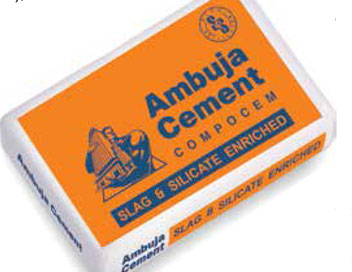Environment. Being future-ready.
Responsible Products GRI-416, 417
Ambuja Cement has set the benchmark for the quality of cement. The main focus is on responsible product design, efficient use of raw materials, sustainable fuel mix and innovative product development. These efforts have enabled us to reduce the environmental impact of our product process/technology over the years. It is difficult to share the use-oriented figures, since cement is a commodity.
Ambuja Cements Ltd. has become the first cement company in India to complete a Life Cycle Analysis (LCA) and develop the Environment Product Declaration (EPD) across all our plants (five integrated units, eight grinding units) for our main product, Portland Pozzolana Cement (PPC), which constitutes over 91% of our production. This is in line with the product category rule CPC 3744 developed by Cement Sustainability initiative (CSI) of World Business Council for Sustainable Development (WBCSD). LCA helps in assessing, evaluating and reducing the environmental burden associated with the product during its entire lifecycle which includes mining, production, transportation, end use and disposal phases. EPD is a type of eco-label which provides information and quantifies the environmental impact of a product, analogous to the nutritional label on a box of cereal. It is being increasingly sought by the business-to-business (B2B) customer segment and green building developers all over the world. It is shortly expected to become a mandatory requirement for business needs in India. The prestigious building rating system LEED (version4) has added new criteria in their evaluation for building product disclosures and optimisation through EPD. EPD is used as a marketing tool by many good building material companies and even other sectors globally. It is a core element of green building certification and is expected to lead to better comparability in future. As a next step, we plan to get our self-declared EPDs certified by an independent third party verifier for publishing on a public website.
 Implementation of LCA and EPD brought to our
attention areas that require further action to maintain
our leadership in sustainable mining and production.
The findings form the basis of short and medium term
strategies to introduce environmentally sensitive and
technically evolved control mechanisms. Primary
2016 data from all units that conform to ISO 14040/44
was used for the LCA. Using the results of the study,
we have prepared a central repository of critical
information that can be used in knowledge building and
sharing of best practices.
Implementation of LCA and EPD brought to our
attention areas that require further action to maintain
our leadership in sustainable mining and production.
The findings form the basis of short and medium term
strategies to introduce environmentally sensitive and
technically evolved control mechanisms. Primary
2016 data from all units that conform to ISO 14040/44
was used for the LCA. Using the results of the study,
we have prepared a central repository of critical
information that can be used in knowledge building and
sharing of best practices.
The Company uses HDPE and biodegradable paper bags for packing cement. Since it is difficult to recollect the bags from our consumers, we have addressed the issue of plastic consumption by co-processing more plastic waste from other sources than the quantity used in our HDPE bags. In 2016, we burnt 51,405 tonnes of plastic waste in our kilns, which is about 1.54 times the total plastic sent to the market as packing bags for our cement, making us a ‘plastic positive’ company. GRI 301-3
The environmental impact of transporting products and other goods, materials and people has reduced over the years (refer to EN18). Bulk cement is being transported through the sea route since 1993. Today the Company owns 10 ships and hires others for transportation of materials. With about 14% of dispatches sent via the sea route and over 24% by rail, more than one third of our outbound logistics is managed in an environment-friendly way. Ambuja Cement initiated Scope-3 emissions estimation for one plant in Rajasthan in 2014. In 2015, the Scope-3 emissions were estimated for all integrated plants. The Scope-3 emission estimation continued in 2016; the scope was extended to include all our integrated plants and grinding units.
In 2016, we have also initiated production of composite cement which is a sustainable product using fly ash and slag in a definite proportion as per BIS norms.